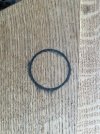Someone left a metal can on my son's white oak table top for some time. The table is on his covered deck. It left a nasty round stain where it sat. See photo. I don't know what to do to remove the ring. I finished the top originally with a poly/blo mixture. I'm afraid that the stain has penetrated deep into the wood but I don't know. Any help on how to refinish the top and remove the ring would be GREATLY appreciated!
Andy
Andy

